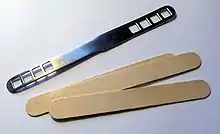Tongue depressor
A tongue depressor (sometimes called spatula[1]) is a tool used in medical practice to depress the tongue to allow for examination of the mouth and throat. The most common modern tongue depressors are flat, thin, wooden blades, smoothed and rounded at both ends,[2] but, historically, tongue depressors have been made of a variety of materials.[3] Since they are inexpensive and difficult to clean because of their porous texture, wooden tongue depressors are labeled for disposal after a single usage.[4]

A tongue depressor may be inserted over the tongue to facilitate insertion of an oral airway and prevent downfolding of the tongue, which could impair venous and lymphatic drainage, causing tongue swelling and airway obstruction.
Hobbyists and teachers have found a multitude of uses for tongue depressors (sometimes called "craft sticks", "popsicle sticks", or "icy pole sticks") in their projects.[5][6] Tongue depressors may be used to form so-called "stick bombs".
Earlier versions of depressors were made from balsa, pine, or redwood woods. Tongue depressors made from wood and metal exist from the American Civil War.[7]
References
- "Spatula", Collins Dictionary of Medicine, Robert M. Youngson 2004, 2005
- Mirriam-Webster's Medical Dictionary
- Cohen, J Solis. Diseases of the Throat and Nasal Passages: A Guide to the Diagnosis and Treatment of Affections of the Pharynx, Oesophagus, Trachea, Larynx, and Nares. Chapter II, Examination of the Throat and Nasal Passages. Published by W. Wood, 1884, 742 pp.
- Landro, L. Hospitals Reuse Medical Devices To Lower Costs Wall Street Journal March 19, 2008.
- Kent Wood, Ric LaBan. N Scale Model Railroad That Grows Kalmbach Publishing, Co., 1996.
- LaBritta Gilbert, Linda Greigg. Do touch: instant, easy hands-on learning experiences for young children Published by Gryphon House, Inc., 1989.
- Echols, M. Items on the 1865 inventory list of the Conesus, N.Y. Military Hospital, June 2010.